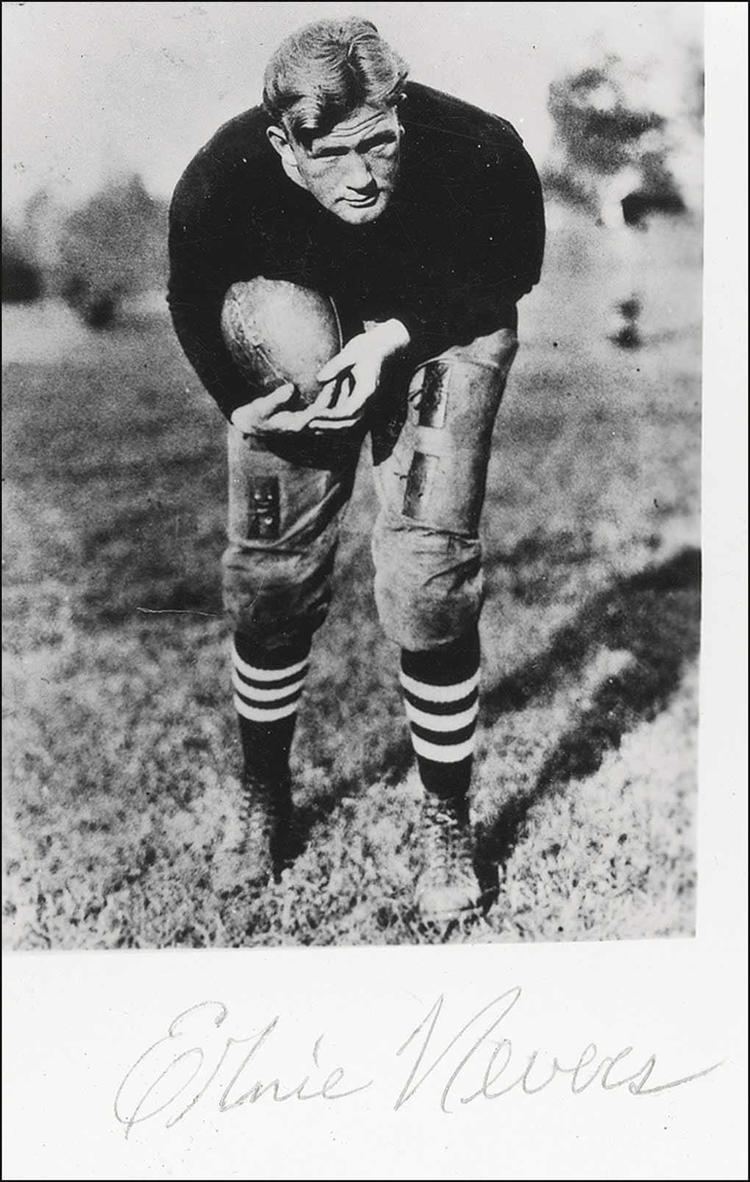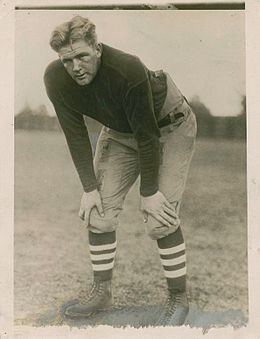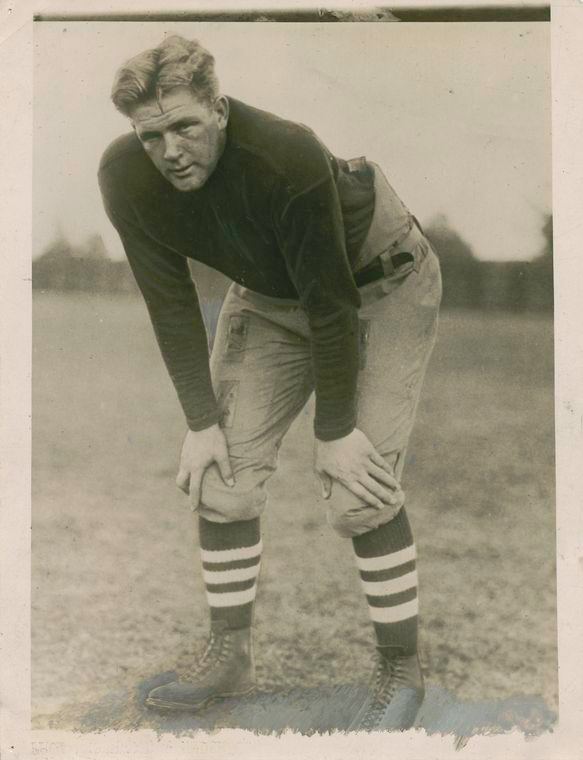Role Baseball athlete | 1927 Duluth Eskimos Positions Fullback Name Ernie Nevers | |
 | ||
Date of birth (1903-06-11)June 11, 1903 Date of death May 3, 1976(1976-05-03) (aged 72) Battles and wars Pacific Ocean theater of World War II Past teams coached Arizona Cardinals (1939–1939), Arizona Cardinals (1930–1931) | ||
Ernie nevers lost footage
Ernest Alonzo Nevers (June 11, 1903 – May 3, 1976), sometimes known by the nickname "Big Dog", was an American football and baseball player and football coach. Widely regarded as one of the best football players in the first half of the 20th century, he played as a fullback and was a triple-threat man known for his talents in running, passing, and kicking. He was inducted with the inaugural classes of inductees into both the College Football Hall of Fame in 1951 and the Pro Football Hall of Fame in 1963. He was also named in 1969 to the NFL 1920s All-Decade Team.
Contents
- Ernie nevers lost footage
- ernie nevers and whitey ford athletes at war
- Early years
- Stanford University
- 192324 academic year
- 192425 academic year
- 1925 season
- Jacksonville football team
- 1926 St Louis Browns
- 1926 Duluth Eskimos
- 1927 St Louis Browns
- 1927 Duluth Eskimos
- Mission Bells and Stanford football
- 1929 season
- 1930 season
- 1931 season
- Coaching career
- Awards and honors
- Family military service and later years
- References

Nevers played four sports (football, basketball, baseball, and track and field) for Stanford University from 1923 to 1925 and was a consensus first-team All-American in football in 1925. He played professional football in the National Football League (NFL) for the Duluth Eskimos in 1926 and 1927 and the Chicago Cardinals from 1929 to 1931. In 1929, he set an NFL record that still stands by scoring 40 points in a single game. Nevers also played professional baseball as a pitcher for the St. Louis Browns of the American League from 1926 to 1928 and the Mission Bells of the Pacific Coast League (PCL) in 1928 and 1929.

Nevers also had a long career as a football coach, including stints with Stanford (assistant, 1928, 1932–1935), the Chicago Cardinals (head coach, 1930–1931, 1939), Lafayette (head coach, 1936), Iowa (assistant, 1937–1938), and the Chicago Rockets (assistant, 1946).

ernie nevers and whitey ford, athletes at war
Early years
Nevers parents, George and Mary Ann Nevers, were immigrants to the United States from New Brunswick, Canada. In addition to Ernie, they had four sons (Frank, John, George, and Arthur) and two daughters (Edith and Stella). By the time Nevers was born, the family had moved from New Brunswick to Willow River, Minnesota, where Nevers was born in 1903. The family moved again to Superior, Wisconsin, where Nevers grew up and attended Central High School. In 1920, the family moved to a ranch and fruit farm in the Rincon Valley section of Santa Rosa in Sonoma County, California. Nevers attended and graduated from Santa Rosa High School where he was a star athlete. He led the Santa Rosa football team to the NCS championship.
In 1921, Nevers attended Santa Rosa Junior College and was the star of the school's football team. In a game against Petaluma, he scored four touchdowns and kicked six field goals and a field goal.
Stanford University
In 1922, Nevers enrolled at Stanford University. He played for the freshman football team at fullback and halfback in the fall of 1922.
1923–24 academic year
As a sophomore, Nevers became a star for the 1923 Stanford varsity football team. He was described as "a sweet punter and a general all-around backfield star" and "the backbone of the Stanford offense."
In the final game of the 1923 season, the dedication game for California Memorial Stadium, Nevers gained more yards than the entire California team. After the game, the Los Angeles Times wrote: "The desperate drive of Ernie Nevers . . . will go down in history as one of the greatest individual efforts ever seen on a gridiron."
At the end of the 1923 season, Nevers was selected by the United Press as the first-team All-Pacific Coast fullback. He was also selected by Walter Camp as the third-team fullback on the 1923 College Football All-America Team.
After the 1923 football season was over, Never demonstrated his overall athletic ability by also starring for Stanford's basketball, baseball and track teams. He was rated as the Pacific coast's best player in both football and basketball, the best college pitcher, one of the leading track performers, and "a crack swimmer" as well. In April 1924, Stanford's assistant director of physical education, Harry Maloney, called Nevers "a freak genius" who also excelled in the classroom.
1924–25 academic year
As a junior, Nevers was sidelined for most of the football season after suffering two broken ankles. Under head coach Pop Warner, the 1925 Stanford football team won the Pacific Coast Conference championship with a 7–0–1 record in the regular season before losing to Notre Dame and the famous Four Horsemen backfield in the 1925 Rose Bowl. Five days after having a cast removed from one of his ankles, Nevers played all 60 minutes of the Rose Bowl, averaged 42 yards on his punts, and carried the ball 34 times for 114 yards, only 13 yards less than all the Four Horsemen combined.
Nevers again proved to be a multi-sport star, competing for Stanford's basketball and baseball teams in the winter and spring of 1925. A newspaper account from February 1925 stated that he was "pressing for honors as the best all around athlete in the annals of the west." During the summer of 1925, Nevers worked for the Starrett Meat Company in Guerneville, California, and pitched for the town's baseball team.
1925 season
As a senior, Nevers and Pop Warner led the 1925 Stanford football team to a 7–2 record. At the end of the 1925 season, Nevers was a consensus All-American, receiving first-team honors from, among others, the All-America Board, the Associated Press, Collier's Weekly, the International News Service, Liberty magazine, the Newspaper Enterprise Association, and Athlete & Sportsman magazine.
Jacksonville football team
In December 1925, Nevers received between $25,000 and $35,000 to play professional football for a team in Jacksonville, Florida. Nevers' team played two exhibition games against NFL opponents: the Chicago Bears, led by Red Grange, on January 2, and the New York Giants on January 9. However, meager crowds forced the team to fold after only two games.
1926 St. Louis Browns
After his first venture with professional football ended, Nevers joined the St. Louis Browns of Major League Baseball. He appeared in 12 games, 11 as a pitcher, for the 1926 Browns, compiling a 2–4 win-loss record and a 4.46 earned run average (ERA) in 74-2/3 innings pitched. At the plate, he had a .185 batting average in 27 at bats. Nevers threw the ball in an unusual underhand delivery. On August 13, 1926, in the highlight of Nevers' 1926 season, he pitched a complete game victory over the Detroit Tigers, giving up eight hits and two runs against a lineup that included Hall of Famers Ty Cobb, Heinie Manush, Charlie Gehringer, and Harry Heilmann, and Bob Fothergill who hit .367 that year.
1926 Duluth Eskimos
In September 1926, Nevers left the Browns to play professional football for the Duluth Eskimos of the National Football League (NFL). Nevers' childhood friend Ole Haugsrud owned the Eskimos. The 1926 Eskimos, with a 16-man roster, played a 29-game schedule and compiled a 19–7–3 record. Nevers reportedly played 1,714 minutes out of a possible 1,740 minutes that year. Highlights of Nevers' 1926 season included the following:
Out of the 29 games played by the Eskimos in 1926, 14 are considered official by the NFL; in those games, Nevers scored 71 points on eight touchdowns, 11 extra points, and four field goals. At the end of his rookie season, Nevers was a consensus pick for the fullback position on the 1926 All-Pro Team, receiving first-team honors from Collyer's Eye magazine, the Chicago Tribune, and the Green Bay Press-Gazette.
1927 St. Louis Browns
Nevers returned to the St. Louis Browns in 1927. He appeared in 33 games for the team, 27 as a pitcher, and compiled a 3–8 win-loss record and a 4.94 ERA in 94-2/3 inning pitched and a .219 batting average in 32 at bats. He is often remembered for having given up two home runs to Babe Ruth during the 1927 season in which Ruth broke the major league record with 60 home runs.
1927 Duluth Eskimos
In 1927, Nevers became head coach of the Eskimos in addition to his regular position at fullback. The 1927 Eskimos compiled a 1–8 record and finished in 11th place in the NFL. Highlights of Nevers 1927 season included the following:
After the season, Nevers was again selected by the Green Bay Press-Gazette, based on the results of a questionnaires sent to the league managers and reporters, as the first-team fullback on the 1927 All-Pro Team.
Mission Bells and Stanford football
Nevers career in Major League Baseball came to an end in the spring of 1928. In six games for the Browns, he compiled a 1–0 record and 3.00 ERA in nine innings pitched. His final major league appearance was on May 4, 1928, at age 25. Nevers was sold by the Browns for $7,500 to the Mission Bells, a Pacific Coast League baseball team in San Francisco, in late May 1928. He appeared in 35 games for the Reds in 1928, compiling a 14–11 record in 206 innings and batting .374 in 91 at bats. Nevers proved a draw for the Mission team, as Stanford fans and locals from Sonoma County flocked to see Nevers pitch.
In March 1928, Nevers announced that he would not return to professional football that fall, opting instead to serve as an assistant coach to Pop Warner at Stanford. Nevers said of professional football: "I hurt my back last year and don't care to take any more chances." He returned to Stanford in September 1928 as coach of the reserve football players.
In February 1929, Nevers resigned from his coaching job at Stanford to return to the Mission baseball club in the PCL. He appeared in 41 games during the 1929 season and compiled a 7–8 win-loss record.
1929 season
In the fall of 1929, Nevers returned to the NFL to play fullback for the Chicago Cardinals. Highlights of Nevers' 1929 season include the following:
At the end of the 1929 season, Nevers was a consensus pick as the fullback on the 1929 All-Pro Team, receiving first-team honors from the Green Bay Press-Gazette, based on the return of 16 ballots sent to the team owners, managers, and sports writers of clubs in the NFL, Collyer's Eye magazine, and the Chicago Tribune.
1930 season
In 1930, Nevers returned to the Cardinals as both head coach and fullback. Highlights of his 1930 season included:
At the end of the 1930 season, Nevers was again selected as the consensus first-team fullback on the 1930 All-Pro Team with Bronko Nagurski being picked for the second team at the position.
1931 season
Nevers returned to the Cardinals as fullback and head coach in 1931. Highlights of his seasons included:
At the end of the 1931 season, Nevers was again selected (for the fifth time in five years in the NFL) as the fullback on the All-Pro Team, receiving first-team honors from the Green Bay Press-Gazette based on the returns of ballots sent to each club in the league as well as sports writers and officials, the United Press, and Collyer's Eye.
On January 25, 1932, Nevers broke his wrist on the final play of a charity football game in San Francisco. Afterward, Nevers announced his retirement as a player, stating that he was getting out while he was "still in one piece," and expressing a desire to pursue a career as a coach.
Coaching career
In March 1932, Nevers was hired as an assistant coach under Pop Warner at Stanford. His initial assignment was to coach the "goof squad". At the end of the 1932 season, Warne resigned as Stanford's head coach, but Nevers remained as an assistant coach under Tiny Maxwell through the 1935 season. During that time, Stanford won three consecutive Pacific Coast Conference championships and played in the 1934, 1935, and 1936 Rose Bowls.
In January 1936, Nevers resigned his position at Stanford to accept the head coaching job at Lafayette College. Nevers was welcomed to the Easton, Pennsylvania, campus with a parade and street celebration as classes were suspended for the day and Lafayette students anticipated the school's "return to 'Big Time' position" of previous years. The 1936 Lafayette team compiled a 1–8 record.
In March 1937, Nevers resigned his post at Lafayette upon being appointed backfield and ends coach for the University of Iowa under head coach Irl Tubbs. Tubbs had been Nevers' high school football coach in Superior, Wisconsin. Nevers coach at Iowa for two years during which time the team compiled records of 1–7 in 1937 and 1–6–1 in 1938.
In December 1938, after the Chicago Cardinals had compiled a 2–9 record during the 1938 season, Nevers was hired as the team's head coach. The 1939 Cardinals compiled a 1–10 record. In February 1940, Nevers resigned from the Cardinals, saying he wished to reside permanently in San Francisco.
Awards and honors
Nevers received numerous honors and awards during and after his playing career, including the following:
Family, military service, and later years
Nevers was married to Mary Elizabeth "Mae" Heagerty in February 1926 in San Francisco.
In September 1942, Nevers enlisted at age 39 in the United States Marine Corps; he was given the rank of captain. In the spring of 1943, he was stationed at the Olds Gunnery School in Lansing, Michigan. While Nevers was stationed at a Marine base in Santa Barbara, California, his wife became ill with pneumonia; she died in a San Francisco hospital in July 1943. Nevers left for the South Pacific theater of World War II in October 1943. In April 1944, he was reported by the Associated Press to have been stationed for the past several months with a marine amphibious unit in the Pacific. In October 1944, Nevers returned to San Francisco after spending 10 months in charge of ground personnel with a squadron in the South Pacific. In December 1944, while stationed at Naval Station Treasure Island in San Francisco, Nevers was promoted to the rank of major. In February 1945, he became the athletic officer at the Marine Corps base in San Diego.
At the end of February 1945, Nevers agreed to serve as an assistant coach with the Chicago Rockets of the All-America Football Conference upon his discharge from the Marine Corps. As of mid-May 1945, Nevers was awaiting his discharge papers and had become associated with a trucking company pending the commencement of his coaching duties with the Rockets. Nevers ultimately served in the fall of 1946 as the backfield coach for the Rockets.
Nevers was remarried to Margery Luxem Railton of Chicago in February 1947. It was the second marriage for both. They had a daughter, Tina (born May 1948), and a son, Anselmo.
After retiring from football, Nevers lived in Strawberry and then Tiburon, both in Marin County, California and worked in public relations and sales promotion for a wine association and a wholesale liquor company. In 1950, Nevers and his wife had a television show broadcast on Friday nights on KGO in San Francisco. In September 1954, Nevers began another television show known as "Out on a Limb With Ernie Nevers".
Nevers died in May 1976 at age 73 at Marin General Hospital in Greenbrae, California. Press accounts differed as to the cause of his death, one indicating that he had been suffering from a kidney disorder, and another saying he had been under treatment for a heart condition. He was buried at Mount Tamalpais Cemetery in San Rafael, California.
